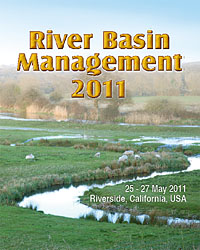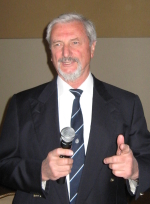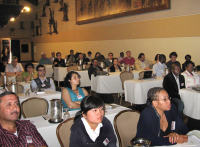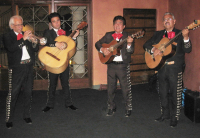River Basin Management 2011
6th International Conference on River Basin Management including all aspects of Hydrology, Ecology, Environmental Management, Flood Plains and Wetlands
25 - 27 May 2011
Riverside, California, USA
Overview
 The 6th International Conference on River Basin Management has taken place in Riverside, California, organised by the Wessex Institute of Technology (WIT), UK, and chaired by Professor Carlos A Brebbia.
The 6th International Conference on River Basin Management has taken place in Riverside, California, organised by the Wessex Institute of Technology (WIT), UK, and chaired by Professor Carlos A Brebbia.
The conference took place in the Mission Inn Hotel, a landmark in the middle of historic Riverside. The hotel, which occupies a whole block, is one of the most celebrated buildings in California.
The Mission Inn began as a two-storey hotel in 1876 and it was purchased in 1902 by Frank Miller, who expanded the original building during a period of 30 years. The design reflects European heritage as well as the character of the renown Californian Missions. The overall effect is an eclectic mixture of different styles and structural shapes. There are numerous sculptures, paintings and bas-reliefs distributed around the building which is now a National Historic Landmark.
The hotel has attracted many distinguished visitors including eleven US presidents. It was the setting for the marriage of Richard and Pat Nixon as well as the honeymoon of Ronald and Nancy Reagan.
The conference dealt with the importance of appropriate management of water resources, a problem of increasing interest. Current concerns are the scarcity and quality of water, and the need to control possible catastrophic events such as floods, and whole range of associated problems like landslides, erosion and many others related to river basins.
Significant advances have been made in the monitoring, analysis and prediction of the behaviour of riverine systems resulting in a better understanding of their mechanism and the possibility of optimizing these resources as well as being able to control or mitigate the effects of major disasters. These developments have been the result of better surveying and measuring techniques, as well as the use of increasingly accurate computer codes. They are also the fruit of better communication between practitioners and academics, through their interaction in joint research projects and regular meetings, including international conferences such as River Basin Management and its associated meeting, Water Resources Management, also organised by the Wessex Institute of Technology.
Opening Address by Professor Carlos Brebbia
 The conference was opened by Professor Carlos A Brebbia, Chairman of the meeting and Director of the Wessex Institute of Technology, who explained the objectives of his institute and of the conference within their programme of activities. These activities include postgraduate research at Master and PhD level, with some programmes in collaboration with universities and research centres from all over the world. The research at WIT emphasises practical application and interdisciplinary studies.
The conference was opened by Professor Carlos A Brebbia, Chairman of the meeting and Director of the Wessex Institute of Technology, who explained the objectives of his institute and of the conference within their programme of activities. These activities include postgraduate research at Master and PhD level, with some programmes in collaboration with universities and research centres from all over the world. The research at WIT emphasises practical application and interdisciplinary studies.
WIT – Professor Brebbia said – participates in a substantial number of international research projects, including some supported by the EU. They offer the opportunity of working as a team with other participants and hence understanding the whole problem, rather than becoming focused only on the particular computational method (WIT is renown throughout the world in the field of computer simulation, particularly because of Professor Brebbia's pioneering work on Boundary Elements).
Collaborative projects – Professor Brebbia explained – are at the core of WIT’s work and are an area to which the Institute also contributes through WIT Press, its publishing arm.
WIT Press publishes nearly 50 books per year, half of which are conference proceedings while the other half are state-of-the-art in a wide variety of topics, including interdisciplinary fields. WIT Press has also launched four important international inter-disciplinary Journals. All of the material is now in digital as well as paper format. The conference proceedings in particular are also archived in the WIT Press eLibrary (http://library.witpress.com) where they are permanently and easily available to the international community.
Professor Brebbia concluded his welcoming remarks by pointing out that WIT’s aim is to act as a hub for knowledge transfer and always welcomes the possibility of collaborating with other institutions. Those associated with WIT through attending conferences, collaborating with WIT Press and other WIT activities are always welcome to visit the WIT campus in the New Forest National Park in Southern England. Visitors will then be able to appreciate better the work of the Institute and to find ways for further collaboration.
Conference Sessions
 The conference sessions covered a series of topics, classified as follows;
The conference sessions covered a series of topics, classified as follows;
- River and watershed management
- River basin management
- Flood studies
- Hydrological modelling
- River restoration and environmental impact
- Water resources management
- Water quality
- Erosion and sediment transport
Invited Presentations
The sessions were enhanced by several invited papers;
‘Innovative river action planning for the Upper Collie catchment, Western Australia’
by Colin Macgregor, The University of Western Australia
‘Evaluation of the interaction between rivers and aquifers for water supply’
by Juan D. Martínez-Nájera, Federal Commission of Electricity, Mexico
‘Analysis of long term hydrological records to assess the changing regime and pathways in oil shale mining districts of North East Estonia’
by Ulo Mander (presented by Riina Vaht, co-author), University of Tartu, Estonia
‘Flood control and small-scale reservoirs’
by Mitsuo Takezawa, Nihon University, Japan
‘Flood risk assessment and management in Slovakia’
by Martina Zelenáková, Technical University of Kosice, Slovakia
‘Application of a geophysical monitoring system on the tidal and salt exposed embankments in the Humber Estuary, UK’
by Zuzana Boukalová, Vodni Zdroje, Czech Republic
‘Application of the MSB coupled embayment pollution-flushing model to Queenstown Creek’
by Stephen Mecca (presented by his co-author Christoph Wegemer, Idyllwild Arts Academy, USA)
‘Stream barb performance in a semi-alluvial meandering channel’
by Ron Townsend, University of Ottawa, Canada
‘Regionalization of droughts in Portugal’
by Maria Portela, Instituto Superior Tecnico, Lisbon, Portugal
‘River systems in transition: pathways and stakeholder involvement’
by Wim Ravesteijn, Delft University of Technology, The Netherlands
Conference Banquet

The conference banquet consisted of a selection of Mexican dishes prepared in the Californian way, accompanied by excellent regional wines. The highlight of the evening was a Mariachi ensemble whose members played popular pieces as well as some Mexican songs requested by the audience (they were even able to master a tango that Carlos with more good will than skill managed to dance!). The friendly atmosphere and convivial environment added to the delegates enjoyment of a unique evening.
International Scientific Advisory Committee
The International Scientific Advisory Committee dinner took place during the last evening of the conference to discuss reconvening the meeting in 2013. Different ideas were discussed including new topics and how the conference should evolve. Nominations for the ISAC were discussed and Carlos will approach some of the names proposed with a view of having a pro-active committee for the 2013 meeting. The conference department at WIT will investigate the different locations and venues put forward during the meeting.
Publication of Papers
The proceedings of River Basin Management VI, 416pp (Print ISBN: 978-1-84564-516-8; Online ISSN: 1743-3541) are available in paper and digital format from WIT Press priced at £179/US$358/€251. Orders can be placed on the WIT Press web site at www.witpress.com or by email:
Papers from the conference will also be hosted online at the WIT eLibrary as Volume 146 of WIT Transactions on Ecology and the Environment (Online ISSN: 1743-3541). For more details visit the WIT eLibrary at http://library.witpress.com


 Wessex Institute
Wessex Institute